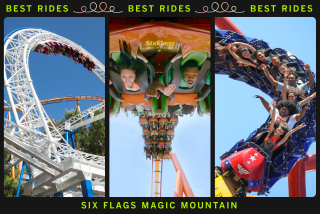MUSEUMS : Spin and Marty Ride Again : Two who grew to fame along with Mouseketeers will take a day to recall life at the Triple R.
- Share via
LOS ANGELES — Before there was Butch and Sundance, there was Spin and Marty (think of them as Butch and Sundance with Clearasil in their pockets). People of a certain age remember them fondly. Indeed, people of a certain age get a few too many drinks in them, and they can sing the entire theme song of “The Adventures of Spin and Marty,” a jaunty little anthem about G-rated good times at the Triple R Ranch. It isn’t pretty, but, then, nostalgia never is.
If you know where your “Spin and Marty” lunch box is at this very moment, you’ll want to check out “Spin and Marty Day” at the Autry Museum of Western Heritage on Sunday. Tim Considine, who broke young girls’ hearts as Spin, will be there, as will David Stollery, who played Marty, the stuck-up one, in the Disney serial.
Harry Carey Jr., who, as the boys’ counselor, regularly separated the squabbling pair, will also appear. The three will talk about the show, answer questions and sign autographs. And you’ll have a chance to see an episode or two from the series or its sequel, imaginatively titled “The Further Adventures of Spin and Marty.” The shows originally aired between 1955 and 1958 as part of “The Mickey Mouse Club.”
According to its stars, the creators of “Spin and Marty” had no idea it would be such a hit, but then who expected singing, dancing preteens wearing mouse ears to sweep the nation? “Spin and Marty” reworked territory as old as myth as it chronicled the adventures of a streetwise city kid and the snotty little rich kid who became his best friend in and around the corral of a California camp for boys. Its eponymous stars were all of 14 when the phenomenon began. They are 54 today, and as surprised as anyone at the show’s prime-time slot in Boomer consciousness.
Why did “Spin and Marty” work and why does it still resonate? J. G. O’Boyle, a cultural analyst based in Philadelphia, notes that the show was basically a buddy movie writ small, as enduring a formula for success as any in American literature.
O’Boyle also speculates that Spin and Marty served as role models for millions of slightly younger kids who sat in front of “The Mickey Mouse Club” like so many jacklighted deer. Who better than Spin and Marty to address such portentous questions as “What’s with girls?”--the principal matter of the second season, after Annette Funicello and her girl gang took up residence at a nearby camp. “That wasn’t something that your parents or your school talked about in those days,” O’Boyle reminds. “You just had to fumble your way through it.”
In O’Boyle’s view, the serial was also boosted by a teen-centric point of view that relegated adults to the periphery. Considine, too, believes Disney hit on something magical when he created a show for youngsters, by youngsters. “You have to look at the time,” says the man who was Spin. “The only programs that were on for kids were puppets or animation. ‘The Mickey Mouse Club’ was the only show that had real kids on it.”
Considine was originally tapped for the role of Marty, who dominated the story as first written. “But I was more of a kid than I was an actor,” Considine recalls, and, as such, he didn’t want to play the hopelessly uncool character. He wanted to be Spin. Horrified that Spin’s role was so small, Considine’s agent lobbied to have it expanded so the boys’ parts had equal weight. Considine then suggested a real-life pal as his co-star, explaining, “Dave Stollery does a real good job of playing snotty little rich kids.”
“Spin and Marty” was a pleasure to do, says Stollery, now an industrial engineer and designer in Laguna Beach. An actor from the age of 6, he had done stage work as well as TV and movies. Theater was especially hard on a child, he recalls, because you had to be quiet backstage. And it was dark and boring, waiting, say, to have fake blood poured on you before you appeared onstage as one of the children slain by Judith Anderson as “Medea.” But “Spin and Marty” was filmed at Walt Disney’s ranch in Placerita Canyon, Stollery says, “and you could go off and practice your roping and pet the horses and generally be outside.”
Stollery quit the entertainment business at 19 to become a prize-winning designer of automobiles. A passion for cars brought the boys together in their “Spin and Marty” days, and it continues to fuel their friendship, both say. Considine, who now lives in Beverly Hills and races and writes about auto racing, remembers that he bought his first race car while still on the show. Stollery expertly drew a picture of it.
*
Considine, who went on to star in “My Three Sons,” says he is most often asked two questions. One is, “Didn’t you used to be Tim Considine?” “What was Annette really like?” is the other.
Funicello was, and is, terrific, Considine says, although there was never anything romantic between them, as teen-zines of the period suggested. He remembers first seeing her at the Disney studio when she was 12 and part of “a group of kids wearing these strange little hats, like yarmulkes with wings.” (The avuncular Mr. Disney is said to have docked the Mouseketeers $50 for every pair of ears they lost.) Considine learned later that Funicello was interested in him, but, he says, “back in those days there were clear lines, and she was on the other side--a mere child.”
As Annette evolved from cute to beach-blanket beautiful, he changed his mind, but it was too late. “By the time she got really pretty and the age difference mattered less, she had moved on and had better taste than to have a crush on me,” he says. “Timing is everything.”
He said he saw Funicello (who has multiple sclerosis) recently, and she is still gorgeous. She was looking at some of their old photos, Considine recalls, then gave him a dazzling smile and observed: “Boy, we were hot then, weren’t we?”
Thousands of former preteens have the lunch boxes to prove it.
(BEGIN TEXT OF INFOBOX / INFOGRAPHIC)
WHERE AND WHEN
What: “Spin and Marty Day.”
Location: Wells Fargo Theater, Autry Museum of Western Heritage, 4700 Western Heritage Way in Griffith Park across from the Los Angeles Zoo.
Hours: 2 p.m. Sunday.
Price: $5.
Call: (213) 667-2000.
More to Read
The biggest entertainment stories
Get our big stories about Hollywood, film, television, music, arts, culture and more right in your inbox as soon as they publish.
You may occasionally receive promotional content from the Los Angeles Times.










